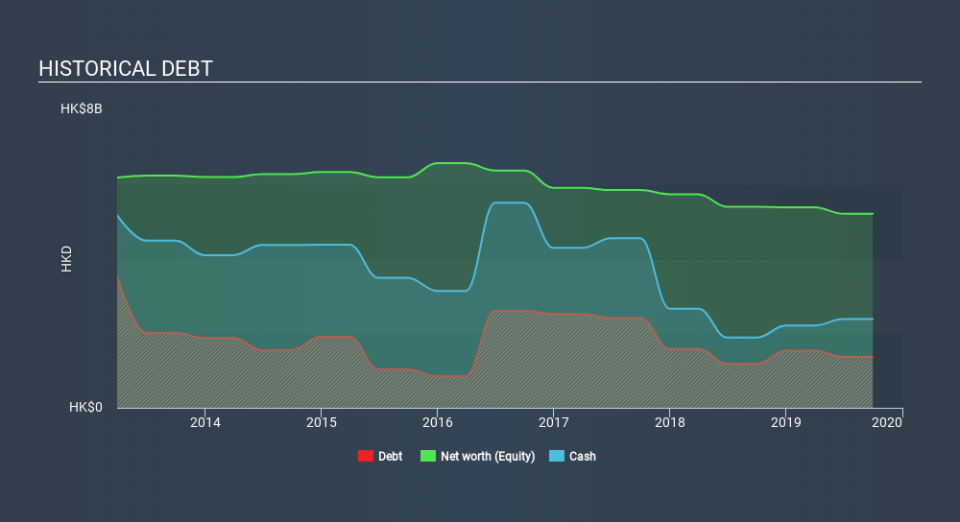Is Texwinca Holdings (HKG:321) Using Too Much Debt?

David Iben put it well when he said, 'Volatility is not a risk we care about. What we care about is avoiding the permanent loss of capital. So it might be obvious that you need to consider debt, when you think about how risky any given stock is, because too much debt can sink a company. We can see that Texwinca Holdings Limited (HKG:321) does use debt in its business. But the more important question is: how much risk is that debt creating?
When Is Debt A Problem?
Debt is a tool to help businesses grow, but if a business is incapable of paying off its lenders, then it exists at their mercy. In the worst case scenario, a company can go bankrupt if it cannot pay its creditors. However, a more frequent (but still costly) occurrence is where a company must issue shares at bargain-basement prices, permanently diluting shareholders, just to shore up its balance sheet. Of course, plenty of companies use debt to fund growth, without any negative consequences. The first step when considering a company's debt levels is to consider its cash and debt together.
Check out our latest analysis for Texwinca Holdings
What Is Texwinca Holdings's Net Debt?
The image below, which you can click on for greater detail, shows that at September 2019 Texwinca Holdings had debt of HK$1.36b, up from HK$1.17b in one year. But it also has HK$2.38b in cash to offset that, meaning it has HK$1.02b net cash.
How Strong Is Texwinca Holdings's Balance Sheet?
Zooming in on the latest balance sheet data, we can see that Texwinca Holdings had liabilities of HK$3.52b due within 12 months and liabilities of HK$493.4m due beyond that. Offsetting this, it had HK$2.38b in cash and HK$1.08b in receivables that were due within 12 months. So its liabilities outweigh the sum of its cash and (near-term) receivables by HK$554.5m.
This deficit isn't so bad because Texwinca Holdings is worth HK$2.42b, and thus could probably raise enough capital to shore up its balance sheet, if the need arose. However, it is still worthwhile taking a close look at its ability to pay off debt. Despite its noteworthy liabilities, Texwinca Holdings boasts net cash, so it's fair to say it does not have a heavy debt load!
The good news is that Texwinca Holdings has increased its EBIT by 9.5% over twelve months, which should ease any concerns about debt repayment. The balance sheet is clearly the area to focus on when you are analysing debt. But it is future earnings, more than anything, that will determine Texwinca Holdings's ability to maintain a healthy balance sheet going forward. So if you're focused on the future you can check out this free report showing analyst profit forecasts.
But our final consideration is also important, because a company cannot pay debt with paper profits; it needs cold hard cash. Texwinca Holdings may have net cash on the balance sheet, but it is still interesting to look at how well the business converts its earnings before interest and tax (EBIT) to free cash flow, because that will influence both its need for, and its capacity to manage debt. During the last two years, Texwinca Holdings produced sturdy free cash flow equating to 52% of its EBIT, about what we'd expect. This cold hard cash means it can reduce its debt when it wants to.
Summing up
While Texwinca Holdings does have more liabilities than liquid assets, it also has net cash of HK$1.02b. And it also grew its EBIT by 9.5% over the last year. So we are not troubled with Texwinca Holdings's debt use. The balance sheet is clearly the area to focus on when you are analysing debt. However, not all investment risk resides within the balance sheet - far from it. Case in point: We've spotted 2 warning signs for Texwinca Holdings you should be aware of.
At the end of the day, it's often better to focus on companies that are free from net debt. You can access our special list of such companies (all with a track record of profit growth). It's free.
If you spot an error that warrants correction, please contact the editor at editorial-team@simplywallst.com. This article by Simply Wall St is general in nature. It does not constitute a recommendation to buy or sell any stock, and does not take account of your objectives, or your financial situation. Simply Wall St has no position in the stocks mentioned.
We aim to bring you long-term focused research analysis driven by fundamental data. Note that our analysis may not factor in the latest price-sensitive company announcements or qualitative material. Thank you for reading.

